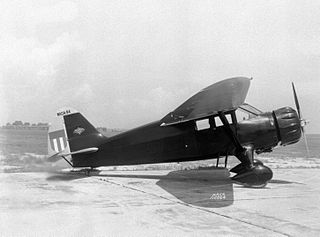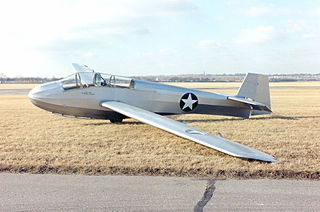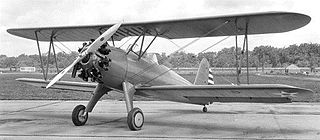Operators

| BG-08 | |
|---|---|
| Role | Two-seat Training Glider |
| National origin | United States |
| Manufacturer | Sailplane Corporation of America |
| Designer | William G Briegleb |
The Briegleb BG-08 was a 1940s two-seat glider designed by William G. Briegleb.
The BG-08 was a high-wing tandem two-seat glider with a steel-tube-and-fabric fuselage, wooden wings with fabric covering and a metal-and-fabric tail. The type certificate was approved on 31 December 1942. [1]
The glider was built by Briegleb's company, the Sailplane Corporation of America. Three gliders were impressed into service with the United States Army Air Forces in 1942. [2]
Related lists

The Fairchild PT-19 is an American Fairchild Aircraft monoplane primary trainer aircraft that served with the United States Army Air Forces, RAF and RCAF during World War II. It was a contemporary of the Kaydet biplane trainer and was used by the USAAF during Primary Flying Training. As with other USAAF trainers of the period, the PT-19 had multiple designation(s) based on the powerplant installed.

The Stinson Reliant is a popular single-engine four- to five-seat high-wing monoplane manufactured by the Stinson Aircraft Division of the Aviation Manufacturing Corporation of Wayne, Michigan.

Military gliders have been used by the militaries of various countries for carrying troops and heavy equipment to a combat zone, mainly during the Second World War. These engineless aircraft were towed into the air and most of the way to their target by military transport planes, e.g., C-47 Skytrain or Dakota, or bombers relegated to secondary activities, e.g., Short Stirling. Most military gliders do not soar, although there were attempts to build military sailplanes as well, such as the DFS 228.

The Schweizer SGS 2-33 is an American two-seat, high-wing, strut-braced, training glider that was built by Schweizer Aircraft of Elmira, New York.

The Interstate Cadet was an American two-seat tandem, high wing, single-engine monoplane light aircraft. Around 320 of these aircraft were produced between the years 1941 and 1942 by the Interstate Aircraft and Engineering Corporation based in El Segundo, California. The construction techniques employed were a welded steel tube fuselage, wood (spruce) wing structure with metal ribs, and fabric covering, all of which were fairly standard in the 1940s.

The Frankfort Cinema was a sailplane manufactured in the United States in the 1930s and 1940s and which was used by the United States Army Air Corps as a training glider under the designation TG-1. It was a high-wing, strut-braced design with a fully enclosed cabin. Originally designed as a single-seater, a two-seat version designated the Cinema II was produced soon afterwards, and this design was put forward when the Army issued a requirement for training gliders. At the same time, the company was awarded production contracts for transport gliders, the CG-1 and CG-2.

The Schweizer SGS 2-8 is an American two-seat, mid-wing, strut-braced, training glider built by Schweizer Aircraft of Elmira, New York.

The Schweizer SGS 2-12 is a United States two-seat, low-wing, training glider built by Schweizer Aircraft of Elmira, New York.
The Briegleb BG-6 was a 1930s single-seat glider designed by William G. Briegleb to be both factory and homebuilt.

The Pratt-Read TG-32 was a 1940s American military training glider, designed and built by the Gould Aeronautical Division of the piano manufacturer Pratt, Read & Company of Deep River, Connecticut, for the United States Navy. The Pratt-Read glider was a monoplane glider having a fabric-covered steel tube fuselage and wooden wings and tail. The unique "polywog (tadpole)" shape was the suggestion of aerodynamicist Charles Townsend Ludington, former owner of the Ludington Line.

The St. Louis YPT-15 was an American two-seat primary training biplane, built by the St. Louis Aircraft Corporation for use by the United States Army Air Corps. 13 examples of the type were acquired, serving in the late 1930s.

The Franklin PS-2 is an American, high-wing, strut-braced, single seat, glider that was designed by R. E. Franklin and produced by the Franklin Glider Corporation starting in 1930.
The Briegleb BG-7 is an American strut-braced high-wing, single seat glider that was designed by William G. Briegleb and produced by the Sailplane Corporation of America as a completed aircraft and also as a kit.

The Midwest MU-1 was an American single-seat, high-wing, strut-braced utility glider that was designed by Art Schultz in the 1930s.
The Frankfort CG-1 was a proposed Second World War American transport glider to be built for the United States Army, none were built and the programme was cancelled.
The Bowlus CG-8 was a prototype Second World War American transport glider to be built for United States Army, one was built but the type did not enter production and the programme was cancelled.
The Bowlus CG-7 was a prototype Second World War American transport glider to be built for United States Army, one was built but the type did not enter production and the programme was cancelled.
The Aero Industries TG-31 was a 1940s American military training glider, designed and built by students at the Aero Industries Technical Institute as the Aero Industries G-2 and impressed into military service as the Aero Industries TG-31 '42-57171' on 29 June 1942.

Victorville Army Airfield auxiliary fields were four airfields used during World War 2 to support the Victorville Army Airfield pilot training near Victorville, California and Adelanto, California. After the war the Victorville Army Airfield was renamed George Air Force Base on January 13, 1948. The airfields were built in 1941 by the United States Army Air Corps just before the war. Victorville Army Airfield covered 2,200-acre in the Mojave Desert. The US Army held a groundbreaking ceremony on 12 July 1941 The base, called Victorville Army Flying School, was ready to use before the attack on Pearl Harbor on December 7, 1941. The Army built four runways in a triangle configuration, with one runway down the middle of the triangle. Seven hangars were built to support operation. On April 23, 1943 the base was renamed Victorville Army Airfield.

The Fletcher BG-2 was a proposed American bomb glider designed by Fletcher Aviation in World War II.